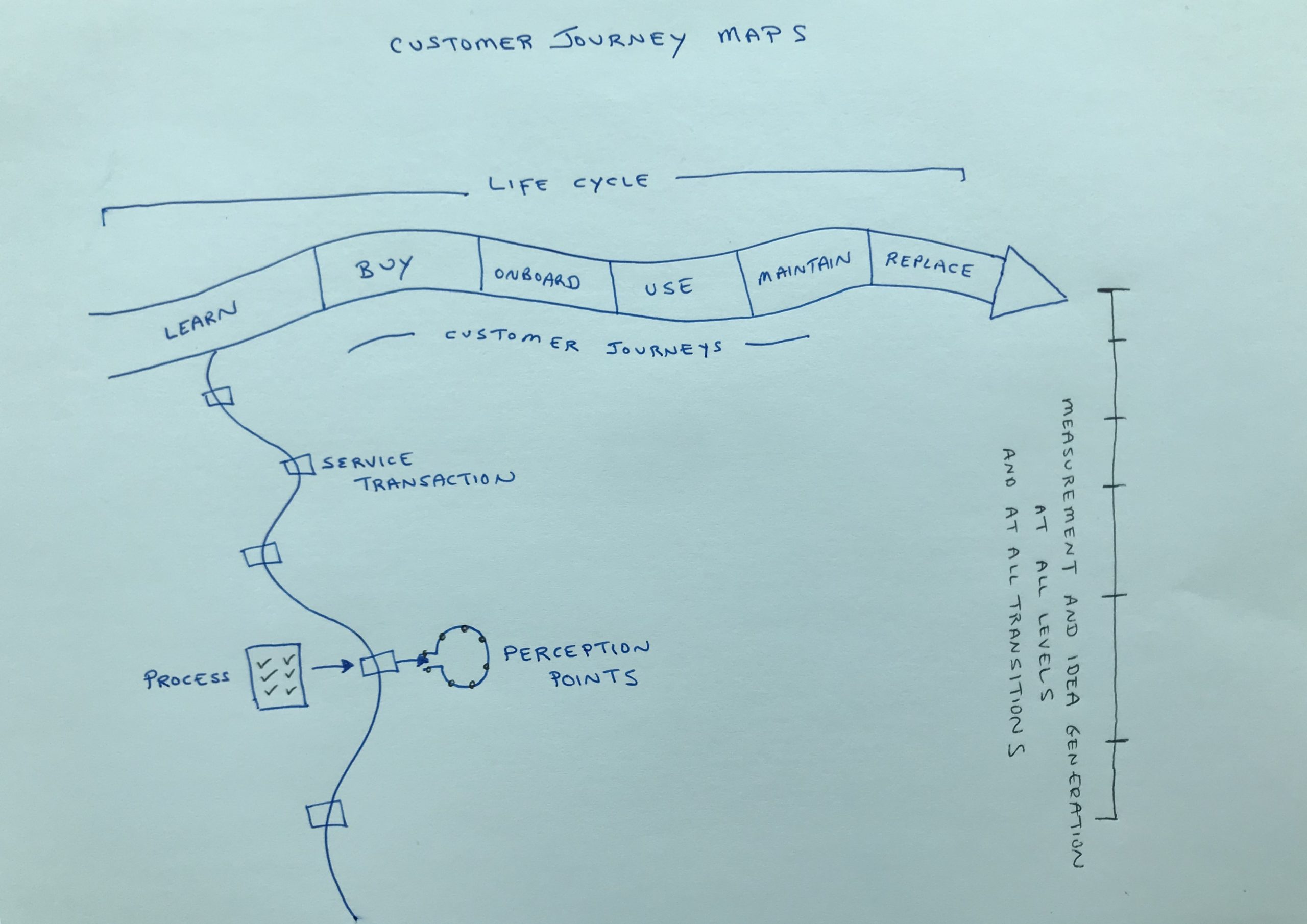
Many organizations are using customer journey mapping to understand and improve the experience of their customers. But the variety of terms used to describe journey maps can be confusing. And that makes the mapping process itself confusing, too.
Let’s clear up the confusion and see how the Uplifting Service toolset adds clarity and power in the process.
What is a Customer Journey Map?
Customer Journey Maps are a visual representation of a customer’s relationship with your people, products, services and brand over time. Journey maps may be created for various customer segments. They can be for internal and external customers. They may include various product lines, service offerings, contact and distribution channels.
A good customer journey map should be easily understood and applied to generate customer experience improvements. However, since each map may represent a complex set of players, interactions, relationships, processes, timelines, and emotions, maps too often become vague or confusing with language and visuals that limit their effectiveness as a communication and improvement tool.
To help you maximize the value and effectiveness customer journey maps, here is a clear structure you can apply to customer journey mapping.
1. The Customer Life Cycle
A natural collection of Customer Journeys over the life of the customer relationship. Other common terms include: cradle-to-grave relationship, end-to-end relationship, customer for life experience, and lifetime customer connection.
2. The Customer Journey
A series of unique paths a customer takes to interact with your company, brand, products, and services over time and across channels. In Uplifting Service terms, this is a series of Service Transactions, also commonly called end-to-end experiences.
For example, an organization may define these common Customer Journeys in a typical Customer Life Cycle:
Learn > Try > Buy > Install > Use > Support > Upgrade
3. The Service Transaction
These are unique and specific transactions experienced by a customer within a journey to obtain the value that they seek. Other common terms include service events, service episodes, and customer interactions. Confusingly, these complete transactions are sometimes called touchpoints. (See #4 below.)
4. The Perception Points
These are individual points within a Service Transaction, or between Service Transactions, where a customer notices something, or experiences something, and forms an opinion about your service. Perception Points are not the process you follow, it is your customer’s experience of your process that matters. Other common terms: moments of truth, moments of magic, moments of misery, pleasure points, and pain points.
5. The Process Steps
These are the consistent, documented sequence of actions and other steps taken by service providers to complete a Service Transaction or transition the customer between Service Transactions. Other common terms include: process map, process flowchart, and checklists.
What are common problems with weak Customer Journey Maps?
How you define the language you use in customer journey mapping impacts your ability to create common understanding, take collective action, and create new value. Lack of clarity and agreement on terms will lead to these unnecessary problems:
Lack of clarity downstream
A web search for “customer journey mapping” returns an enormous collection of terms and phrases. However, many are used interchangeably, the same word may describe different levels of detail, and the result is predictable confusion.
The words you choose is less important than making and promoting a clear choice, defining a simple hierarchy with clear distinctions at every level.
Ineffective measurement of service
Being clear about what you are doing at each stage of a journey map helps you choose the right measurements for that level of the map. You can measure many things about service and customer experience, but these measurements may not be well connected to each stage of your customer’s overall journey.
Unfocused generation of new ideas
You may want to involve your employees and partners in generating new service improvement ideas. But an unfocused request for “ideas to help us make service better” will produce a list of equally unfocused ideas.
A better approach is to solicit ideas with clear focus on key areas at each stage of the customer mapping process, on specific outcomes you wish to achieve, and for specific customer segments taking the journey.
An effective Customer Journey Map, with each level and each term clearly understood, allows you to isolate key points of joy to be expanded or enhanced, and key points of frustration to be eliminated or significantly improved.
Ultimately, Perception Points is the level where opportunities for service improvement will be implemented. But without a clear hierarchy of terms and understanding, your team may not focus on these points, may miss seeing what causes problems at these points, and may fail to generate good ideas to improve service at these points.
Gradual decline of engagement and service culture
Customer Journey Maps are often used in an attempt to build a more customer-centric culture. But poorly defined maps create more confusion and questions than insight and answers. When struggling with vague or confusing maps, you may hear reactions that point to barriers deeply embedded in existing systems, practices, process, policies, traditions, and leadership behaviors. Common reactions from colleagues include; “We don’t really understand the issue…”, “We can’t do this because…”, and “They won’t let us do that…”
However, by looking holistically and working with well-defined Customer Journey Maps, you can bring everyone to a shared view on what needs to be improved, and what barriers are standing in the way. Overcoming “we can’t” becomes easier when everyone can see the problems. A culture of service excellence accelerates when everyone can work solving these problems together.
Are you using Customer Journey Maps where you work, or do you plan to use them in the future?
If so, we hope this article helps you create clarity and communicate easily to generate new ideas for improvement.




